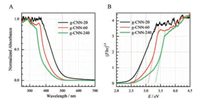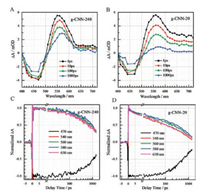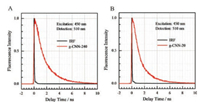Graphitic carbon nitride (g-CN) has attracted considerable attention since the pioneering work reported by Wang and coworkers in 2009 [1]. g-CN has been successfully used in a wide range of photocatalytic applications such as water splitting [2-6], carbon dioxide reduction [7-10], pollutant degradation [11-13], and bacterial disinfection [14, 15]. There are numerous studies related to g-CN on how to optimize its photocatalytic performance under solar light irradiation [16-22]. However, the origin of its photocatalytic activity, particularly the charge transport process of g-CN is seldom reported. Up to date, there are only a few transient absorption spectroscopy studies on g-CN in literatures to address its charge carrier kinetics [23, 24]. This is in particular due to the fact that it is difficult to produce a g-CN sample having near-optical quality [25].
In the recent, we investigated the charge carrier kinetics of g-CN nanoflakes (g-CNN) with few layers by using femtosecond transient absorption spectroscopy [26]. We found a new and positive absorption band appears in its femtosecond transient absorption spectrum, which could be attributed to the absorption of the electronic excited state (or the photogenerated electron/hole pair) of g-CNN after light excitation. In combination with the result obtained from a picosecond time-resolved fluorescence measurement, we proposed a kinetic scheme to understand the photophysics and charge carrier kinetics of g-CNN after light excitation. But there still remains unanswered question, for example, the difference in the ultraviolet visible diffuse reflectance spectrum (UVDRS) between g-CNN and bulk g-CN.
Herein, we prepared g-CNN sample with various layers through controlling the heating reflux time of bulk g-CN in tetraethylammonium hydroxide (N(CH2CH3)4OH) aqueous solution and studied their photophysics and charge carrier kinetics by using UVDRS, atomic force microscopy (AFM), picosecond time-correlated single photon counting, and femtosecond transient absorption spectroscopy. We found that the indirect bandgap for g-CNN with few layers is larger than that for g-CNN with most layers. We also found that the charge carrier kinetics for g-CNN with few layers is slower than that for g-CN with most layers.
The g-CN sample was synthesized according to the procedure described by Thomas and coworkers [27]. Briefly, 10 g dicyandiamide (DCDA) was put into a close crucible and was heated to a designed temperature of 650 ℃ with a 2.3 ℃/min ramp rate, where it was held for 4 h. After cooling to room temperature, the product was milled into a fine powder in an agate mortar for further characterization and measurement. The g-CNN sample was produced according to the method reported by Panasiuk and coworkers [28]. Briefly, 0.10 g bulk g-CN was mixed with 10.00 mL 1.36 mol/L N(CH2CH3)4OH aqueous solution and kept for a certain time at boiling temperature (about 100 ℃) with magnetic stirring and using a reflux condenser to avoid water evaporation.
The UVDRS of g-CNN was recorded on a Shimadzu UV-3600 spectrophotometer equipped with a diffuse reflectance accessory, where its absorption spectrum was referenced to BaSO4. The AFM image of g-CNN was recorded on a Bruker Dimension Icon microscope. The femtosecond transient absorption study of g-CNN was performed on a home-made femtosecond transient absorption spectroscopy setup [29]. Briefly, the outputs of a Spectra Physics 1 kHz amplified Ti:sapphire laser were used to pump an optical parametric amplifier (OPA) and to generate the white light continuum. The outputs of the OPA were used as the pump pulses, and the white light continuum generated by a spinning fused silica disk were used as the probe pulses. The timing between the pump and probe pulses was controlled by a Newport M-ILS250CC motorized translation stage. The time resolution of this apparatus was about 150 fs. The fluorescence lifetime of g-CNN was measured using a home-made time correlated single photon counting apparatus [30]. Briefly, the outputs of an OPA pumped by a Spectra Physics 1 kHz amplified Ti:sapphire laser were used as excitation sources. The emission was collected and sent into a Princeton Instruments SP2358 monochromator and detected with a Hamamatsu R3809U-50 MCP-PMT. Next the signal from the R3809U-50 MCP-PMT was amplified by a Becher & Hickl GmbH HFAC-26 preamplifier. Then the output of the HFAC-26 preamplifier and the output of a fast PicoQuant TDA 200 photodiode were connected to a Becher & Hickl GmbH SPC-130 module, respectively, as the start and stop pulses. The instrumental response function of this setup was about 70 ps.
Fig. 1A shows the normalized UVDRS of g-CNN prepared with different heating reflux time of bulk g-CN in 1.36 mol/L N(CH2CH3)4OH aqueous solution, respectively. The symbol g-CNN-x stands for the sample prepared with x minutes heating reflux time of bulk g-CN in 1.36 mol/L N(CH2CH3)4OH aqueous solution. It is clear that the absorption band edge of g-CNN shifts to blue as the increasing the reflux time of bulk g-CN in N (CH2CH3)4OH aqueous solution. The sample g-CNN-240 has a shorter wavelength absorption band edge while the sample g-CNN-20 has a longer wavelength absorption band edge. From the Tauc plot shown in Fig. 1B, we determined that the indirect bandgap for g-CNN-20, g-CNN-60, and g-CNN-240 is about 2.60, 3.08, and 3.31 eV, respectively. It is obvious that the indirect bandgap for g-CNN-240 is about 0.70 eV larger than that for g-CNN-20.

|
Download:
|
| Fig. 1. (A) Normalized UVDRS of g-CNN-20, g-CNN-60 and g-CNN-240, respectively; (B) Tauc plot of g-CNN-20, g-CNN-60 and g-CNN-240, respectively | |
It is reported that the interlayer interaction/coupling in 2-dimensional layer material (2DLM) can dramatically affect its band structure so as to exhibiting distinct layer-dependent electronic and optical properties [31-38]. Many few-layered 2DLMs such as black phosphorus [32], MoS2 [33-36], WS2 [37], and PtS2 [38] have showed layer-dependent bandgaps. The g-CNN is also a 2DLM which should also display a layer-dependent bandgap. To confirm this suggestion, we performed the AFM measurements for g-CNN-20 and g-CNN-240. Fig. 2A displays the AFM image of g-CNN-20. Fig. 2B shows the AFM image of g-CNN-240. Fig. 2C shows the height profiles of g-CNN-20 measured along the lines marked on Fig. 2A. Fig. 2D shows the height profiles of g-CNN-240 measured along the lines marked on Fig. 2B. Fig. 2E displays the height distributions of g-CNN-20 evaluated from the AFM image shown in Fig. 2A. Fig. 2F displays the height distributions of g-CNN-240 evaluated from the AFM image shown in Fig. 2B.

|
Download:
|
| Fig. 2. (A) AFM image of g-CNN-20; (B) AFM image of g-CNN-240; (C) Height profiles of g-CNN-20 measured along the lines marked on A; (D) Height profiles of gCNN-240 measured along the lines marked on B; (E) Height distributions of g-CNN-20 evaluated from A; (F) Height distributions of g-CNN-240 evaluated from B | |
With the data shown in Fig. 2C, we determined that the average thickness for g-CNN-20 is 9 ± 2 nm and that the lateral size for g-CNN-20 is 240 ± 30 nm in diameter. With the data shown in Fig. 2D, we determined that the average thickness for g-CNN-240 is 1.0 ± 0.4 nm and that that the lateral size for g-CNN-240 is 230 ± 20 nm in diameter. The thickness of g-CNN-20 is distinctly thicker than that of g-CNN-240. With the reported thickness for a single-layered g-CNN [28], we derived that the CN layer number for g-CNN-20 is about 20 and that the CN layer number for g-CNN-240 is around 2. The CN layer number for g-CNN-20 is distinctly larger than that for g-CNN-240. These results clearly demonstrated that the interlayer interaction plays an important role on the photophysics of g-CNN. Besides, our results also suggested that the g-CNN with few layers has a larger indirect bandgap and that the g-CNN with most layers has a smaller indirect bandgap, which is well consistent with the literature's report where Zhao and coworkers [38] found that few-layered PtS2 has a layer-dependent indirect bandgap from 1.6 eV of monolayer to 0.25 eV of bulk. To our knowledge, this is the first report to address that g-CNN has a layer-dependent bandgap.
To deep understand the photophysics of g-CNN, we further performed the femtosecond transient absorption spectroscopy measurements on g-CNN-20 and g-CNN-240, as shown in Fig. 3. Fig. 3A displays the femtosecond transient absorption spectra of g-CNN-240 at various time delays. Fig. 3B displays the femtosecond transient absorption spectra of g-CNN-20 at various time delays. The obtained femtosecond transient absorption spectrum of g-CNN-240 is consistent with our previous report [26]. The negative absorption band in the femtosecond transient absorption spectrum of g-CNN-240 is attributed to its electronic ground-state absorption and the positive absorption band in femtosecond transient absorption spectrum of g-CNN-240 is attributed to the absorption of its new-generated charge carrier. The common feature of the femtosecond transient absorption spectrum of g-CNN-20 is similar as that of g-CNN-240. But, the positive absorption band in the femtosecond transient absorption spectrum of g-CNN-20 is obviously broader than that of g-CNN-240. Besides, the time evolution of the femtosecond transient absorption spectrum of g-CNN-20 is faster than that of g-CNN-240. The difference in the femtosecond transient absorption spectrum between g-CNN-20 and g-CNN-240 reveal that the interlayer interaction of g-CNN-20 may have an obvious effect on its charge carrier process.

|
Download:
|
| Fig. 3. Top panel: Femtosecond transient absorption spectra of g-CNN-240 (A) and g-CNN-20 (B) at various time delays; Bottom panel: Probe wavelength dependence of magic-angle pump-probe kinetic traces of g-CNN-240 (C) and g-CNN-20 (D). The pump wavelength for the femtosecond measurements are 450 nm | |
To interpret the charge carrier kinetics of g-CNN-240 and g-CNN-20, we further recorded their magic-angle pump probe kinetic traces at different probe wavelengths, respectively, as shown in Figs. 3C and D. The kinetic trace at 470 nm probe wavelength reflects the recovery of the electronic ground-state of g-CNN after light excitation and the kinetic traces at probe wavelength of 540, 560, 580 and 650 nm reflect the formation and decays of the new-generated charge carrier of g-CNN. Interestingly, the recovery of electronic ground-state of g-CNN-20 is slightly faster than that of g-CNN-240, but the decays of the new-generated charge carriers of g-CNN-20 are distinctly faster than that of g-CNN-240. Besides, all decays of the new-generated charge carriers of g-CNN-20 at probe wavelength of 540, 560, 580 and 650 nm show a non-exponential decay character. These observations suggest that the charge carrier kinetics of g-CNN-20 is more complicated than that of g-CNN-240.
The kinetic data of g-CNN-240 can be interpreted by the model suggested in our previous report [26]. However, the kinetic data of g-CNN-20 cannot explained by our earlier suggested model, indicating that additional decay channel may occur in the depopulation of the new-generated charge carrier of g-CNN-20. Merschjann and coworkers [24] have suggested a predominance of interplanar transport model for the charge carrier of bulk g-CN. They found that the electronic transport in bulk g-CN is predominantly perpendicular to the sheets/layers, which is in clear contrast to the electronic transport in graphene. Herein, we have confirmed that the interlayer interaction of g-CNN-20 is extremely stronger than that of g-CNN-240 from the UVDRS results (Fig. 1). Thus, it is reasonable to assume that the interlayer/ interplanar electronic transport process also occurs in the charge transfer process of g-CNN-20, which is consistent with the suggestion by Merschjann and coworkers [24]. In addition, we determined that the layer number of g-CNN-240 is only 1-2. Then, the interlayer electronic transport process may not be important in the charge transfer process of g-CNN-240. This may suggest that the electronic transport process in g-CNN-240 is predominant an inplanar electronic transport process. As a consequence, the current study also indicated that the model suggested in our previous report [26] could be an inplanar electronic transport model.
We also recorded the fluorescence decays of g-CNN-240 and g-CNN-20 by using picosecond time-correlated single photon counting measurement, as shown in Fig. 4. With the data shown in Fig. 4A, it is determined that the fluorescence lifetime of g-CNN-240 is about 1.60 ns. With the data shown in Fig. 4B, it is determined that the fluorescence lifetime of g-CNN-20 is about 1.20 ns. The fluorescence lifetime of g-CNN-20 is about 25% shorter than that of g-CNN-240, which is consistent with our femtosecond measurement.

|
Download:
|
| Fig. 4. Fluorescence decay curves of g-CNN-240 (A) and g-CNN-20 (B). Excitation wavelength: 450 nm; detection wavelength: 510 nm. IRF is the instrumental response function. | |
In conclusion, we prepared g-CNN with various layers through controlling the heating reflux time of bulk g-CN in N(CH2CH3)4OH aqueous solution. We studied the photophysics and charge carrier kinetics of g-CNN with various layers by using UVDRS, AFM, picosecond time-correlated single photon counting, and femtosecond transient absorption spectroscopy. We found that g-CNN has a layer-dependent indirect bandgap. The bandgap for g-CNN with few layers (g-CNN-240) is larger than that for g-CNN with most layers (g-CNN-20). We also found that g-CNN has layerdependent charge carrier kinetics. The charge carrier kinetics for g-CNN with few layers (g-CNN-240) is slower than that for g-CNN with most layers (g-CNN-20). These preliminary results indicated that the interlayer interaction plays an important role in the photophysics and kinetics of g-CNN.
AcknowledgmentsFinancial supports by the National Natural Science Foundation of China (No. 21373269) and the Fundamental Research Funds for the Central Universities and the Research Funds of Renmin University of China (No. 10XNJ047) are gratefully acknowledged.
| [1] |
X. Wang, K. Maeda, A. Thomas, et al., Nat. Mater. 8 (2009) 76-80. DOI:10.1038/nmat2317 |
| [2] |
J. Zhang, G. Zhang, X. Chen, et al., Angew. Chem. Int. Ed. 51 (2012) 3183-3187. DOI:10.1002/anie.v51.13 |
| [3] |
P. Niu, G. Liu, H.M. Cheng, J. Phys. Chem. C 116 (2012) 11013-11018. DOI:10.1021/jp301026y |
| [4] |
A.B. Jorge, D.J. Martin, M.T.S. Dhanoa, et al., J. Phys. Chem. C 117 (2013) 7178-7185. DOI:10.1021/jp4009338 |
| [5] |
Y. Zhong, Z. Wang, J. Feng, et al., Appl. Surf. Sci. 295 (2014) 253-259. DOI:10.1016/j.apsusc.2014.01.008 |
| [6] |
Q. Gu, Y. Liao, L. Yin, et al., Appl. Catal. B 165 (2015) 503-510. DOI:10.1016/j.apcatb.2014.10.045 |
| [7] |
G. Dong, L. Zhang, J. Mater. Chem. 22 (2012) 1160-1166. DOI:10.1039/C1JM14312C |
| [8] |
J. Mao, T. Peng, X. Zhang, et al., Catal. Sci. Technol. 3 (2013) 1253-1260. DOI:10.1039/c3cy20822b |
| [9] |
P. Niu, Y.Q. Yang, J.C. Yu, G. Liu, H.M. Cheng, Chem. Commun. 50 (2014) 10837-10840. DOI:10.1039/C4CC03060E |
| [10] |
J. Lin, Z. Pan, X. Wang, ACS Sustain. Chem. Eng. 2 (2014) 353-358. DOI:10.1021/sc4004295 |
| [11] |
Y. Cui, Z. Ding, P. Liu, et al., Phys. Chem. Chem. Phys. 14 (2012) 1455-1462. DOI:10.1039/C1CP22820J |
| [12] |
M. Shalom, S. Inal, C. Fettkenhauer, D. Neher, M. Antonietti, J. Am. Chem. Soc. 135 (2013) 7118-7121. DOI:10.1021/ja402521s |
| [13] |
Y. Ishida, L. Chabanne, M. Antonietti, M. Shalom, Langmuir 30 (2014) 447-451. DOI:10.1021/la404101h |
| [14] |
J. Huang, W. Ho, X. Wang, Chem. Commun. 50 (2014) 4338-4340. DOI:10.1039/c3cc48374f |
| [15] |
H. Zhao, H. Yu, X. Quan, et al., Appl. Catal. B 152- 153 (2014) 46-50. |
| [16] |
X. Wang, S. Blechert, M. Antonietti, ACS Catal. 2 (2012) 1596-1606. DOI:10.1021/cs300240x |
| [17] |
S. Cao, J. Yu, J. Phys. Chem. Lett. 5 (2014) 2101-2107. DOI:10.1021/jz500546b |
| [18] |
S. Cao, J. Low, J. Yu, M. Jaroniec, Adv. Mater. 27 (2015) 2150-2176. DOI:10.1002/adma.201500033 |
| [19] |
Y. Zheng, L. Lin, B. Wang, X. Wang, Angew. Chem. Int. Ed. 54 (2015) 12868-12884. DOI:10.1002/anie.v54.44 |
| [20] |
W.J. Ong, L.L. Tan, Y.H. Ng, S.T. Yong, S.P. Chai, Chem. Rev. 116 (2016) 7159-7329. DOI:10.1021/acs.chemrev.6b00075 |
| [21] |
W. Jiang, W. Luo, J. Wang, M. Zhang, Y. Zhu, J. Photochem. Photobiol. C 28 (2016) 87-115. DOI:10.1016/j.jphotochemrev.2016.06.001 |
| [22] |
J. Wen, J. Xie, X. Chen, X. Li, Appl. Surf. Sci. 391 (2017) 72-123. DOI:10.1016/j.apsusc.2016.07.030 |
| [23] |
C. Ye, J.X. Li, Z.J. Li, et al., ACS Catal. 5 (2015) 6973-6979. DOI:10.1021/acscatal.5b02185 |
| [24] |
C. Merschjann, S. Tschierlei, T. Tyborski, et al., Adv. Mater. 27 (2015) 7993-7999. DOI:10.1002/adma.201503448 |
| [25] |
H.Y. Zhang, A.C. Yu, J. Phys. Chem. C 118 (2014) 11628-11635. DOI:10.1021/jp503477x |
| [26] |
H.Y. Zhang, Y.P. Chen, R. Lu, R.Y. Li, A.C. Yu, Phys. Chem. Chem. Phys. 18 (2016) 14904-14910. DOI:10.1039/C6CP01600F |
| [27] |
A. Thomas, A. Fischer, F. Goettmann, et al., J. Mater. Chem. 18 (2008) 4893-4908. DOI:10.1039/b800274f |
| [28] |
Y.V. Panasiuk, A.E. Raevskaya, O.L. Stroyuk, P.M. Lytvyn, S.Y. Kuchmiy, RSC Adv. 5 (2015) 46843-46849. DOI:10.1039/C5RA01652E |
| [29] |
R.X. Zhu, X. Li, X.S. Zhao, A.C. Yu, J. Phys. Chem. B 115 (2011) 5001-5007. DOI:10.1021/jp200876d |
| [30] |
H.Y. Zhang, S. Li, R. Lu, A.C. Yu, ACS Appl. Mater. Interfaces 7 (2015) 21868-21874. DOI:10.1021/acsami.5b06309 |
| [31] |
A.J. Bradley, M.M. Ugeda, F.H. da Jornada, et al., Nano Lett. 15 (2015) 2594-2599. DOI:10.1021/acs.nanolett.5b00160 |
| [32] |
J. Qiao, X. Kong, Z.X. Hu, F. Yang, W. Ji, Nat. Commun. 5 (2014) 4475. |
| [33] |
K.F. Mak, C. Lee, J. Hone, J. Shan, T.F. Heinz, Phys. Rev. Lett. 105 (2010) 136805. |
| [34] |
R. Ganatra, Q. Zhang, ACS Nano 8 (2014) 4074-4099. DOI:10.1021/nn405938z |
| [35] |
Z. Yu, Y. Pan, Y. Shen, et al., Nat. Commun. 5 (2014) 5290. DOI:10.1038/ncomms6290 |
| [36] |
J. Hong, Z. Hu, M. Probert, et al., Nat. Commun. 6 (2015) 6293. DOI:10.1038/ncomms7293 |
| [37] |
W. Zhao, Z. Ghorannevis, L. Chu, et al., ACS Nano 7 (2013) 791-797. DOI:10.1021/nn305275h |
| [38] |
Y. Zhao, J. Qiao, P. Yu, et al., Adv. Mater. 28 (2016) 2399-2407. DOI:10.1002/adma.201504572 |
 2018, Vol. 29
2018, Vol. 29 


